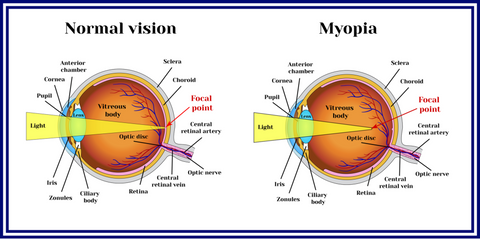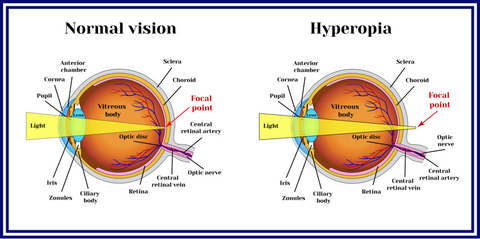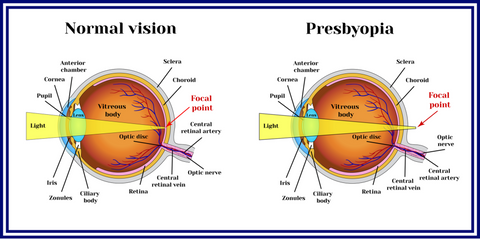
With all eye examinations, it’s not just a refraction for new glasses, it’s a general health check of your eyes. Generally an eye examination will last for 30 to 40 minutes, which allows the Optometrist to thoroughly examine the health of the eyes, correct the visual needs & obtain the best vision possible for the patient.
All the usual tests are preformed to check for the best visual needs for either spectacles or contact lenses. Most examinations are adjusted to be more specific for the individual needs, and different checks can be performed.
All examinations include a digital retinal photograph with Fundus camera, which allows the smallest of abnormalities to be detected, recorded & compared at future checks.
Alex Optical have also invested in new equipment to complete the examination, a digital Phoropter for refractions, iCare contact tonometer for eye pressure, Henson Visual field analyser and Topcon Topographer as well as the TOMEY Fundus camera.
Myopia

The definition of Myopia (short sight) is where the eye is longer than normal or the cornea is too steep, meaning that light rays focus in front of the retina. Near objects are clear, but distant objects appear blurred.
For the most part, this is an inconvenience considering how frustrating it can be to be dependent on contact lenses or spectacles. In addition, eyes with a high degree of Myopia are at an increased risk of developing a serious condition like retinal detachment or glaucoma.
Hyperopia

The definition of Hypermetropia (long sight) is where the eye is shorter than normal or the cornea is too flat, meaning that light rays focus behind the retina. Light rays from close objects such as pages of a book cannot be focused on clearly by the retina. Someone with hyperopic eyes may find their vision is blurred when looking at objects near to them, and for vision to be clearer when looking at far away objects.
A degree of hyperopia is common in many people, although this only presents a problem when our ability to see is significantly affected or where headaches and eye strain are common.
Presbyopia

Presbyopia is the inability of the eye to focus the lens for near objects. When we are young, the lens of the eye can change its shape allowing us to focus on near objects. After the age of 40, the lens becomes noticeably more rigid and reading at close range becomes increasingly difficult. This condition is defined as presbyopia and is a normal part of ageing.
Dry Eyes
A very common condition where the eyes do not make enough tears, or the tears evaporate too quickly. It is common with heavy computer use and with those aged over 40 years old, mainly women, but it can happen at any age.
Certain medications and medical conditions can also make the eyes very dry.
With the increase use of electronic devices in recent years, even very young children can suffer from dry eyes.
Dye eyes is also common in those with blepharitis and contact lens wearers.
Symptoms are gritty, sore, tired eyes that get worse during the day, with a sensitivity to light. Sometimes it can be very painful. Occasional intermittent blurred vision happens as the surface of the eyes dries. The eyes can look red eye, sometimes be sticky and be tearing, to have 'watery eyes'.
Blepharitis
Blepharitis refers to the inflammation of the lid margins, top and/or bottom. The area around the roots of the eye lashes become swollen & red, can be itchy and to look 'crusty'. Often, the glands on the lid margins become blocked too. Sometimes in the mornings its difficult to open the eyes, as they can be come stuck together also resulting in dry eyes.
At Alex Optical we specialize with dry eyes & Blepharitis. By far the most common way to deal with mild to moderate cases is the use of artificial tears, gels and ointments. Also to have good lid hygiene and to use warm compresses, which are very useful when the dry eyes are associated with Blepharitis.
In more severe cases punctum plugs, Omega 3 supplement, cyclosporine drops and anti-inflammatory drops have to be taken if your Ophthalmologist advises it.
Cataract
A cataract is a clouding of the normally clear lens of your eye. For people who have cataracts, seeing through cloudy lenses is a bit like looking through a frosty or fogged-up window. Clouded vision caused by cataracts can make it more difficult to read, drive a car (especially at night) or see the expression on a friend's face.
Most cataracts develop slowly and don't disturb your eyesight early on. But with time, cataracts will eventually interfere with your vision. At first, stronger lighting and glasses can help you deal with cataracts. But if impaired vision interferes with your usual activities, you might need cataract surgery. Fortunately, cataract surgery is generally a safe, effective procedure.
Most cataracts develop when aging or injury changes the tissue that makes up your eye's lens. Some inherited genetic disorders that cause other health problems can increase your risk of cataracts. Cataracts can also be caused by other eye conditions, past eye surgery or medical conditions such as diabetes. Long-term use of steroid medications, too, can cause cataracts to develop.
Glaucoma
Glaucoma is a group of eye conditions that damage the optic nerve, the health of which is vital for good vision. This damage is often caused by an abnormally high pressure in your eye. Due to either increased production of fluid within the eye, or narrowing or blockages of the drainage channels of the fluid.
Glaucoma is one of the leading causes of blindness for people over the age of 60.
It can occur at any age but is more common in older adults. Many forms of glaucoma have no warning signs. The effect is so gradual that you may not notice a change in vision until the condition is at an advanced stage.
Vision loss due to glaucoma can't be recovered, it's important to have regular eye exams that include eye pressure checks so a diagnosis can be made in its early stages and treated appropriately. If glaucoma is recognized early, vision loss can be slowed or prevented. If you have the condition, you'll generally need treatment for the rest of your life.
Macular Degeneration
Macular Degeneration or MD is the leading cause of vision loss. It is caused by the deterioration of the central portion of the retina. The inside layers of the back of the eye which records the images and sends them via the optic nerve to the visual cortex in the brain for us to see! The central portion of the retinal is called the macular, and is used for focusing the central vision, and gives us the ability to read, drive recognize faces and see objects in fine details.
When the cells of the macular deteriorate, the images it sends to the brain are incomplete. In the early stages the vision isn't always effected.
As the disease progresses, vision is greatly effected. Blurry and wavy vision is noted, and central vision is completely lost while peripheral vision remains prefect.
There are different types of MD classed as "Wet" and "Dry" and is classified as Early, intermediate and Late stages of MD. The risks of MD are age, genetic, race and smoking. Its always advised to wear sunglasses to give protection of harmful UV rays, and taking Omega-3 supplements.
When MD is detected early injections are sometimes used to treat which can help prevent severe loss of vision, and slow down the progression of the disease.




